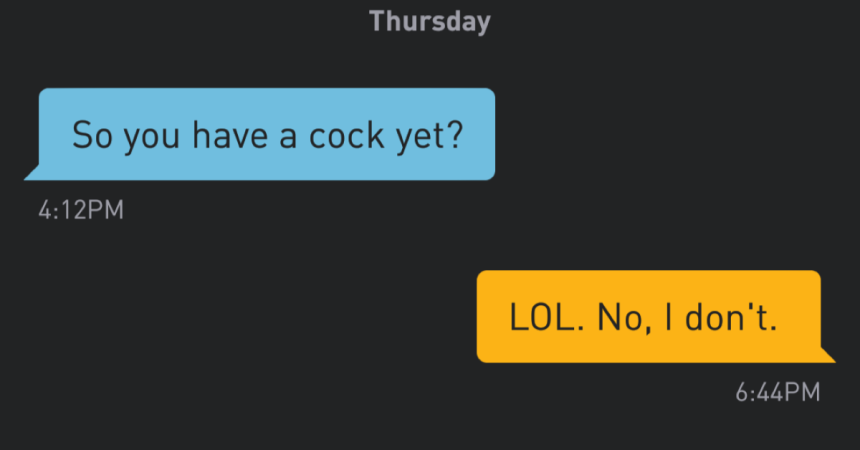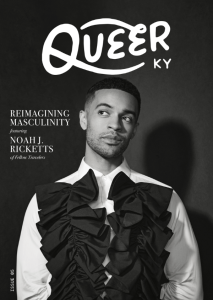Thinking Queerly: Trans men can’t top (and other cis-conceptions)
After recovering from my last breakup, I decided to get on the apps (the dating and hookup apps, that is). Gay hookup apps allow you to state your sexual preferences: are you a top, bottom, versatile, and so forth. As I was creating my first profile, on Scruff, this option gave me pause.
How do I identify? For me, as a trans man, this question has always required some extra unpacking. Think of a prank birthday present, where the gift is placed in a box that’s been wrapped in multiple layers of duct tape, which has been placed in a box that’s been wrapped in multiple layers of duct tape…and so on. If the gift I’m unpacking is my “true identity,” then the duct tape is society’s expectations of me, and the boxes are the labels that I pass through and discard along the way.
For example: the first person I came out to as trans was one of my exes—a lesbian who I’d been with for three years. I knew on an intuitive level that she (and others, such as certain family members) would be resistant to the idea of me identifying as a man and transitioning. Since I was not prepared for our relationship to end, I turned a blind eye to my intense chest and lower dysphoria, and the euphoria I experienced when people gendered me male. I told myself that I didn’t need to experience this euphoria, that a gender-neutral name and pronouns would be enough for me. It wasn’t. It was just a box, covered in so much duct tape.
Before that relationship ended, when I was still struggling to accept my identity, my therapist suggested a thought experiment. She said “Pretend for a moment that your girlfriend, your family, and anyone else whose opinion matters to you, does not exist. It’s just you, and folks who don’t have an opinion about your gender. What would you do?” The answer was so easy: I would use he/him pronouns, change my name, have surgery, go on hormones. “Well there you go,” she said. I wasn’t satisfied. Those people did exist, and their opinions would still matter to me when I left their office. So how would this thought experiment help me decide which pronouns to use, or whether or not I should transition? My therapist explained that coming to terms with my identity is different from sharing that identity with the world. The thought experiment was just supposed to help me get clear on who I am. What I do with that information is a separate question. But before I can decide what I want to do, I have to know who I am.
Silly as it sounds, I found myself at a similar crossroads when I created my profile on Scruff. Confronted with a choice to “identify” as a top, a bottom, or a vers, I immediately started thinking about how the cis guys on the app would receive my decision.
A common assumption that cis gay men have, is that all trans men are bottoms (that is, we prefer to receive penetration rather than give it). “Anatomically, it just makes sense!” they reason. However, this reasoning is felatious—I mean—fallacious. Sexual preferences, such as liking to penetrate vs. liking being penetrated — are only partly determined by one’s anatomy (or the parts one has and their capacity for being stimulated in different ways.) Much like gender, the rest is mental. The existence of big burly bottoms with 9 inch dicks is not contested amongst the gays. We all know that a guys height, build, and dick size doesn’t tell you whether he is a top or a bottom. Trans men are no different: you can’t tell from our size, our build, or our parts, the kind of sex we prefer. Anatomically, trans men can absolutely get off by topping—regardless of whether or not we have had lower surgery. And there are a number of ways we can penetrate a partner, be that with our “Tdick” or a prosthetic. In fact, one perk of being topped by a trans man is that you have a choice as far as length, girth, and rigidity. So really, what’s not to want?
But how many cis gays understand this? And how many cis bottoms are interested in being topped by a trans man? And how dysphoric would it make me to top a bottom who has only ever been with cis men? And what kinds of hurtful messages will show up in my inbox if I put “trans and top” or “trans and vers” on my profile? Also why is there duct tape in my hair??
I took a breath and reminded myself of what my therapist said, that how I identify is different than what I choose to do about it. So I selected the option that felt safest and most comfortable for me at the time, and gave myself room to explore and experiment, to wrap and unwrap (as it were) my desires and preferences.
What did I find?, you might be wondering. Here is the thing. Queerness, for me, is a rejection of the narrative that says that who I am is fixed, stable, and/or pre-determined from the womb. Most of the words that I use to describe myself—man, gay man, trans man, bisexual man, queer man etc.—while very useful in certain contexts, don’t fully capture my experience. In a way, queerness for me is the acknowledgment that “words fall short.” That is to say, words fall short of my identity, which is complex and at times, fluid. But doesn’t Gaga say that we were “born this way??” She did, and maybe she was right, or partly right. Maybe you were born gay, and maybe I was born with a knack for unpacking things, an activity that comes so naturally to me that it would be weird if one day it just stopped.
Okay, but what’s your preference? Are you a top? A bottom? Vers? We can discuss, but you’ll have to match with me first. 😉












Leave a Reply
Want to join the discussion?Feel free to contribute!